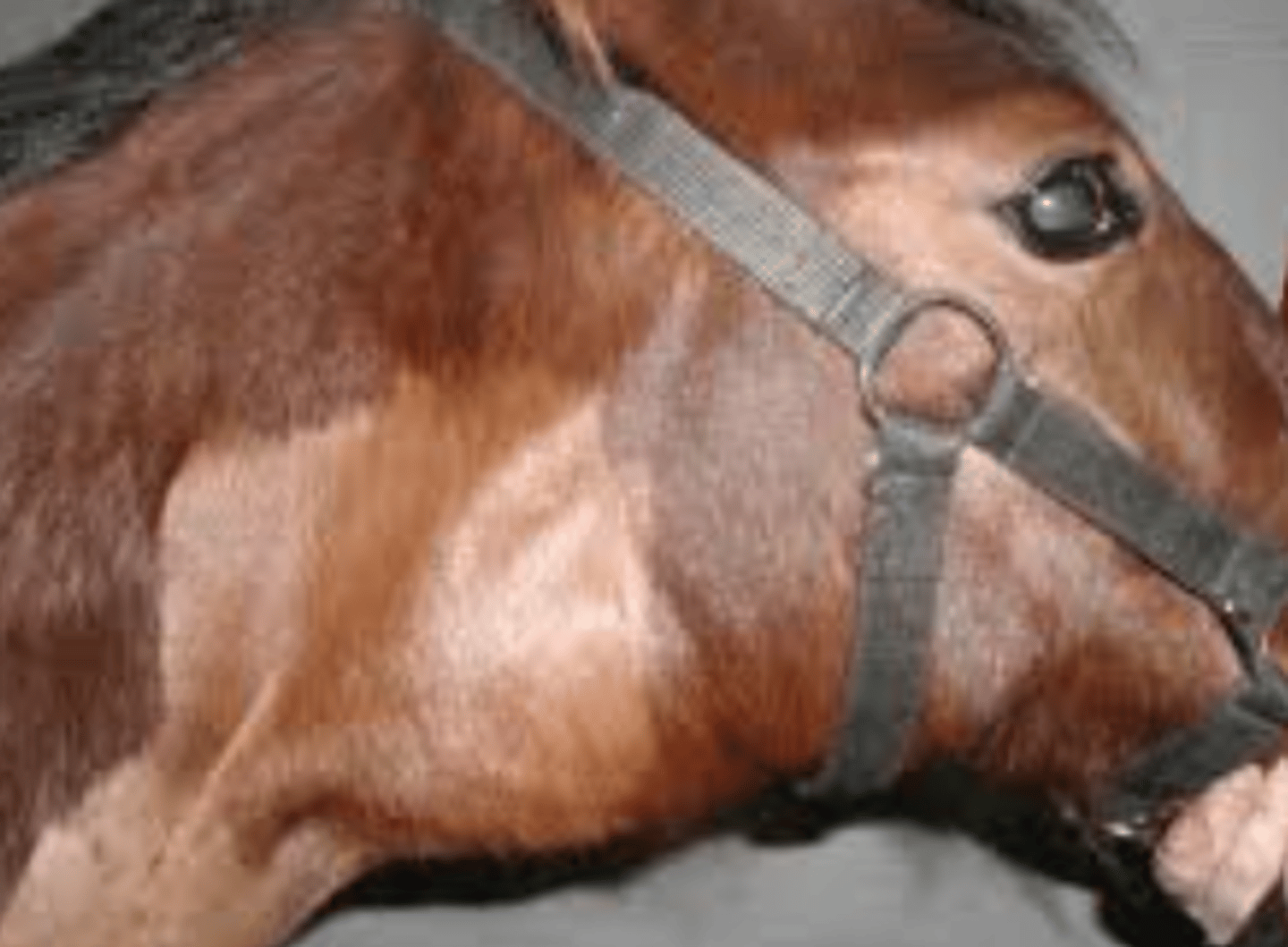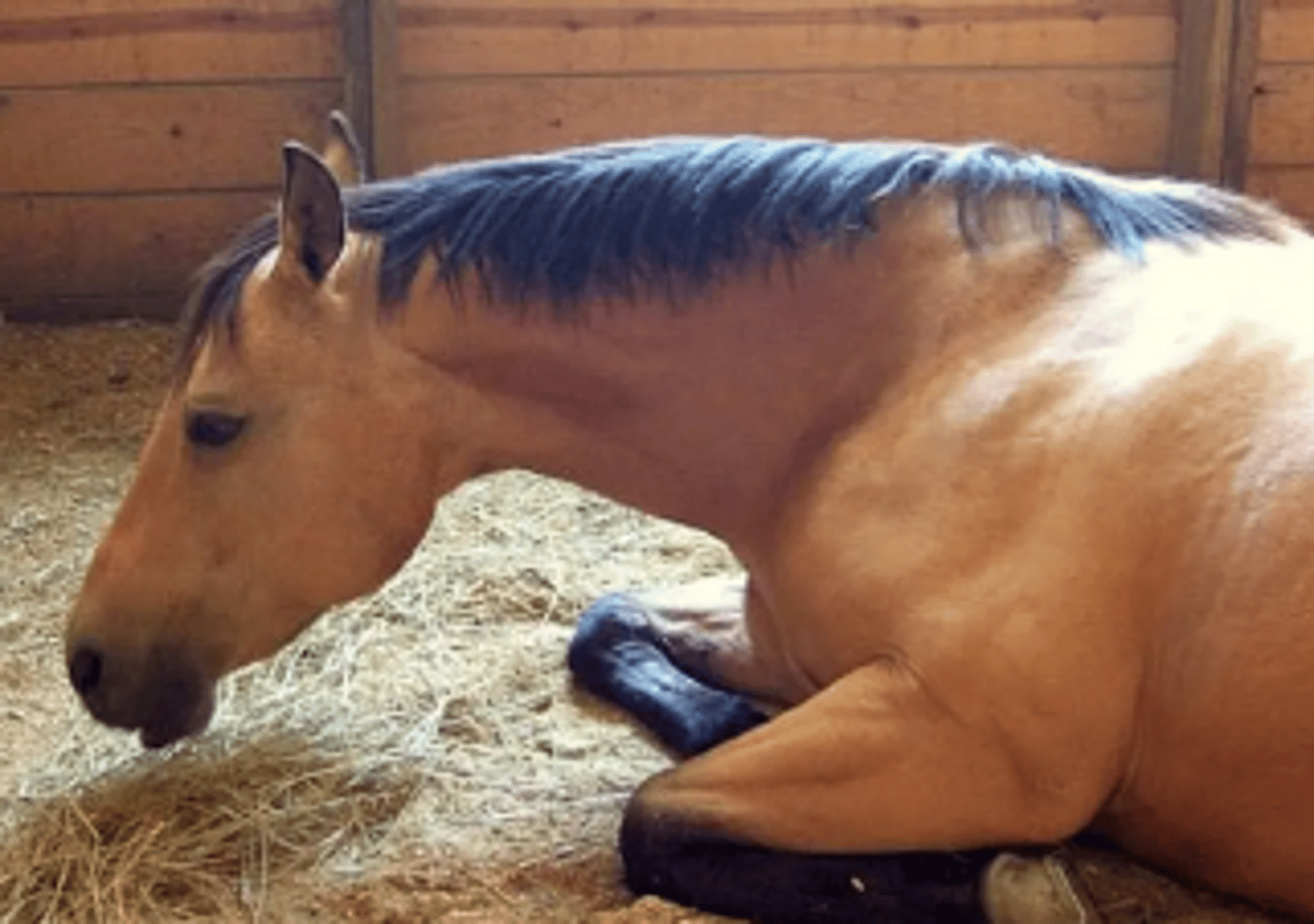ANSC 625 - Equine/Ruminants Infectious Respiratory Disease (Exam II)
1/57
There's no tags or description
Looks like no tags are added yet.
Name | Mastery | Learn | Test | Matching | Spaced |
|---|
No study sessions yet.
58 Terms
empyema and mycosis
What are the two guttural pouch diseases?
pus in the pouch that typically occurs with upper respiratory bacterial infections
What happens during empyema of the guttural pouch?
fungal infection in pouch caused by Aspergillus that can erode pouch lining, damaging carotid arteries and cranial nerves
What happens during mycosis of the guttural pouch?
nasal dishcarge, painful swelling in area, cranial nerve deficits, most common first sign being enlarged submandibular lymph nodes
What are the signs of guttural pouch disease?
radiographs and endoscopy
How can you diagnose guttural pouch disease?
systemic and local antimicrobial therapy
How can you treat guttural pouch disease?
guttural pouch disease (empyema or mycosis)
This horse is having difficulty chewing and nasal discharge alongside this observed sign. What could be happening?

equine herpesvirus 1 and 4
What is the pathogen of equine viral rhinopneumonitis?
2-10 days
What is the incubation period for equine virual rhinopneumonitis?
rhinopharyngitis, tracheobronchitis, and pneuomonitis
Equine viral rhinopneumonitis can cause what conditions?
fever, nasal discharge cough, inappetence, and/or enlarged lymph nodes of the head, often complicated by secondary bacterial infections
What are the signs of equine virual rhinpneumonitis?
abort
Pregnant mares can do what weeks to months after infection with EHV-1?
viral pneumonitis
Mares exposed late in gestation to EHV-1 may give birth to live foals with ______
neurologic disease
Specific strains of EHV-1 can cause ____ with signs ranging from mild incoordination to paralysis
recurrence of disease and shedding of virus
Many adults are latently infected with EHV-1 and EHV-4 with stress or immunosuppression resulting in what?
direct or indirect contact with infectious nasal secretions and aborted tissues and fluids
How is equine viral rhinopneuominitis transmitted?
PCR or virus isolation from nasopharyngeal swab, aborted tissue, or CSF
How can you diagnose equine viral rhinopneumonitis?
supportive care, anti-viral medications
How can you treat equine virual rhinopneumonitis?
good biosecurity, minimizing stress, not allowing horses to leave premises until 3 weeks after recovery from last case, vaccination of foals at 4-6 months of age with vaccine boosters during pregnancy
How can you control equine viral rhinopneumonitis?
yes
Is equine viral rhinpneumonitis reportable in NH?
an orbivirus (non-enveloped RNA)
What is bluetongue?
domestic and wild ruminants,
Bluetongue is a disease that infects who?
equine viral rhinopneumonitis
This horse is having trouble with coordination and has discharge coming from its nostrils. What could be happening?

yes (mostly seen in south and west US)
Is bluetongue reportable in NH?
true
True or false - mortality of bluetongue ranges widely with serotype and host
vector (bite of Culicoides midges)
How is bluetongue spread?
subclinical
_____ disease (no obvious signs) is very common with bluetongue
chronic and acute
What are the two types of bluetongue that can occur?
dyspnea, fever, frothing from nostrils, death due to pulmonary edema, facial edema, nasal congestion, hemorrhages in oral membranes, tongue swollen/cyanotic, inflammation of hoof vasculature
What occurs during acute bluetongue?
unthrifty, wool break, reproductive losses, secondary bacterial infections
What occurs during chronic bluetongue?
vasculitis (observed post-mortem)
____ increases vessel permeability, causing edema and hemorrhage in the lungs and heart during bluetongue
signs and lesions of endemic areas and confirmed with virus isolation, PCR, and/or serologic response
How can you diagnose bluetongue?
no
Is there a treatment for bluetongue?
vaccination prior to and during outbreak (if serotype is identified and matched), reducing vector species
How can you control bluetongue?
pregnant ewes can abort or give birth to lambs with CNS abnormalities, vaccine associated virus can spread by vector and reassort with wild type to lead to new viral serotypes
What can be a consequence of using a bluetongue vaccine?
infectious/inflammatory condition of the lungs
What is pneuomonia?
dyspnea, cyanosis, coughing, fever, in severe cases appetite and growth rate decrease
What are the common signs of pneuomonia (general)?
true
True or false - there are often abnormal lung sounds on auscultation with pneumonia
respiratory irritants, bacteria, viruses, parasites, and fungus (is often a mix)
What can cause pneumonia (general)?
poor ventilation, stress and overcrowding, inadequate biosecurity, inadequate testing and vaccination prorgrams
What are some contributing factors to the development of pneumonia?
improving management, treating the treatable and providing supportive care, and improving immunity
What should be focused on in cases of pneumonia?
pulmonary infection characterized by inflammation and necrosis due to inhalation of foreign material
What is aspiration pneumonia?
inappropriate administration of oral drugs, aggressive dip technique, primary neurologic disease that affects swallowing, recumbency, esophageal disease that leads to reflux
What are the possible causes of aspiration pneumonia?
inflammation and necrosis of tissue, cranioventral parts of lung (may be unilateral in animals in which lateral recumbency was cause of aspiration)
What are the lesions of aspiration pneumonia and where are they found?
based on signs and history
How is aspiration pneumonia diagnosed?
transtracheal wsah
Fluid collected during ______ can be cultured to help identify pathogens involved during aspiration pneumonia
broad spectrum antibiotics when first suspect aspiration has occurred
How is aspiration pneumonia treated?
lentivirus, single stranded enveloped RNA
what is ovine progressive pneumonia (OPP)?
true
True or false - OPP is a significant cause of decreased production in US sheep with relation to CAE
maedi-visna (dyspnea-wasting)
How is OPP known outside of the US?
long incubation period (2-4 years) with slow progression of disease
What aspect of OPP makes it particularly difficult to control?
No - 100% fatal
Is there treatment for OPP?
it has a long incubation time (2-4 years)
Why is OPP typically seen in older animals?
emaciation/wasting, increasing dyspnea, encephalitis and mastitis possible
What does the slow progression of OPP look like?
they become large, heavy, and firm with enlarged lymph nodes
What happens to the lungs during OPP?
vertically (consumption of colostrum/milk) and horizontally (inhalation of respiratory droplets)
How is OPP transmitted?
serologic testing
How can you diagnose OPP?
testing with isolation or culling of infected animals
How can you control OPP?